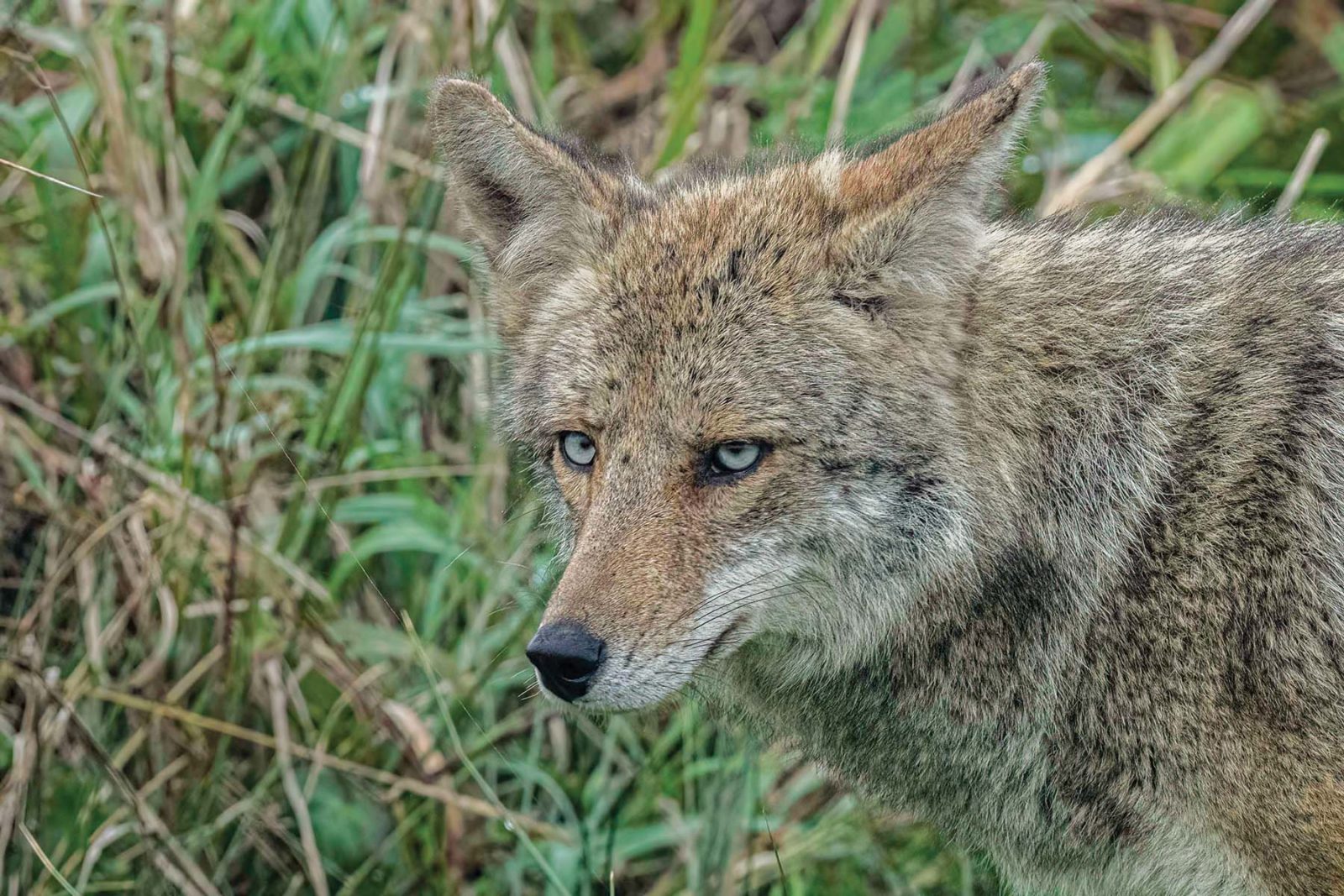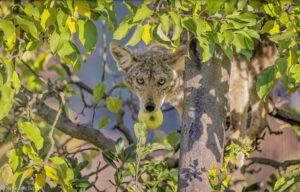
Spring is the perfect time for a photo session on the Point Reyes peninsula. It’s birthing season for many animals, including elk, bobcats, and coyotes. Flowers are blooming and the weather is mild. And, if you’re lucky and use a zoom lens, you might see a coyote with piercing blue eyes gracing your photo album.
Sightings of coyotes with steely irises are sporadic and rare, so no one is sure how many individuals there are in the park or if their population is increasing or decreasing. But every so often a photographer will capture an image of one. “The blue-eyed coyotes certainly seem restricted to the Point Reyes area, and particularly the outer peninsula,” says David Press, a wildlife ecologist at the Point Reyes National Seashore. “Which is a little bit surprising because there is a lot of movement with coyotes around Marin, even between Marin and San Francisco.”
The peninsula’s striking blue-eyed coyotes made national headlines in 2019 after they were photographed by Point Reyes photographer Daniel Dietrich, spurring articles in National Geographic, Smithsonian, and Atlas Obscura. People have also photographed blue-eyed coyotes in other populations in Santa Cruz and Sacramento.
Normally coyotes are born with blue eyes that turn yellowish-brown as they get older. So why do some coyotes retain blue eyes into adulthood?
“The short answer is we don’t know, but there’s several fascinating hypotheses that require some careful testing,” James Brooks, a PhD candidate at the Wildlife Research Center at Kyoto University wrote in an email.
In an article in the journal Behavior in 2020, Brooks and several colleagues showed that coyotes in areas with more housing density reacted more “boldly” to human-made novel items such as cameras in places they hadn’t been before. And seven of the coyotes their camera traps observed had some physical anomaly, such as black or brindled fur or white patches, features the paper labeled “domestication traits.” While most purely wild animals have little variation in their fur and eye color, plenty of domestic animals—dogs, horses, reindeer, camels, and cattle—do.
So, are blue eyes indicative of domestication? Seven unusual coyotes don’t tell us much. In an experiment started in the 1950s that’s still controversial today, Soviet geneticist Dmitri Belyaev tried to see if he could create more human-friendly foxes through artificial selection. Over time Belyaev’s friendly foxes started to show “domestication traits” similar to the ones that Brooks noticed in coyotes, like multicolored fur. Multicolored fur, like blue eyes, tends to occur more in domesticated animals.
Some coyote populations and individuals have found an urban niche, and the ones that hang out close enough to humans to be photographed may be disproportionately tame. “[M]any have reasoned that urban environments might shape behavior in similar ways, that urban wildlife might be bolder, less reactive, less aggressive to humans,” Brooks wrote, “and therefore may be expected to show some of the morphological outcomes we see in domestic animals.”
A second, related hypothesis is that the blue-eyed coyotes could be part dog. Brooks and Press agree that further research is necessary, and Press doesn’t completely rule out the possibility of genes coming from domestic dogs in the family tree. There’s genetically nothing stopping coyotes from breeding with dogs, and coydog puppies can breed with coywolves and wolfdogs indefinitely until they’re all just a bunch of Canis soup. However, Callie Broaddus wrote in National Geographic in 2019 that this possibility is unlikely, as coydogs tend to have a variety of doggy features, but not blue eyes.
And, finally: sometimes a new physical trait will just appear in an animal. Every sexually reproducing animal is a little different from its parents: for instance, each human has 100 to 200 mutations. It’s plausible that some coyote developed this trait a few generations ago and there is simply not enough of a reason for nature to wipe it out—especially in a world made so hospitable to coyotes by people who wiped out other competing predators. “There’s all sorts of genotypes that get expressed in different ways in wildlife, and this is potentially just one other example,” Press says.
While blue eyes could be harmful to coyotes, it’s probably not too bad if the trait has persisted. And remember that mutations are a natural and important part of life—if they didn’t occur, every human and coyote would still be a single-cell organism.




